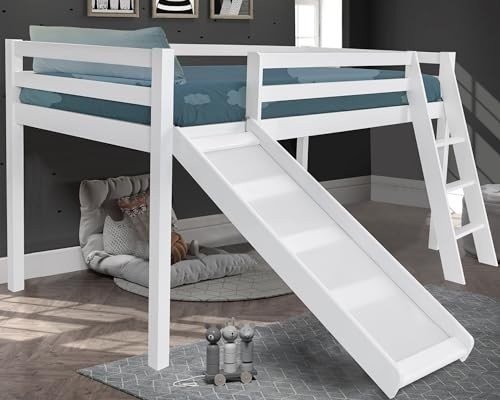20 Things You Should Be Asking About Bunk Bed Before You Buy Bunk Bed
A Comprehensive Guide to Children's Bunk Beds: Styles, Benefits, and Safety Considerations
Bunk beds have ended up being a popular choice for families seeking to take full advantage of space and provide an enjoyable sleeping environment for children. With their special style, they use an imaginative and practical service for shared bedrooms, playrooms, and even guest accommodation. This article explores the different styles of children's bunk beds, their advantages, safety factors to consider, and answers some frequently asked questions.
The Allure of Bunk Beds
Kid's bunk beds are more than simply space-saving structures; they are likewise a gateway to daring dreams and creative play. Below is a comprehensive evaluation of their various advantages.
Benefits of Bunk Beds
- Space-Saving: Bunk beds efficiently utilize vertical space, making them a perfect choice for smaller sized spaces.
- Playful Design: Many bunk bed designs consist of slides, camping tents, and themed elements, sparking imagination and excitement.
- Partner Sharing: Bunk beds are ideal for siblings sharing a room or accommodating sleepovers.
- Flexible Use: Some designs can be separated into 2 individual beds, providing flexibility as kids grow.
- Storage Options: Many bunk beds come with integrated drawer storage or shelves, even more enhancing their practicality.
Styles of Children's Bunk Beds
The range of bunk beds offered today caters to various choices and needs. Below is an introduction of some popular styles.
Design
Description
Best For
Standard Bunk Bed
A traditional style including one bed stacked above another.
Siblings sharing a space.
Loft Bed
Similar to a bunk bed without the bottom bunk, permits a work area or play location listed below.
Restricted space for play/desk.
L-Shaped Bunk Bed
2 beds arranged in an L-shape, typically with extra areas for storage or play.
Distinct room designs.
Twin Over Full
A twin bed over a full bed, accommodating different sleep requirements.
Growing kids and teens.
High Sleeper
Stands even greater than a loft bed, typically featuring a desk or play area listed below.
Older kids requiring more play/desk space.
Tent Bunk Bed
Bunk beds with a canopy or tent-like structure, producing a relaxing, enjoyable space.
Active and imaginative kids.
Secret Features to Consider
When choosing the best bunk bed for kids, the following features deserve considering:
- Material: Bunk beds can be made from wood, metal, or a mix. Each has its distinct aesthetic and resilience.
- Weight Capacity: Always verify the weight limit of the bunk bed to ensure it can accommodate your kids safely.
- Safety Rails: Ensure the leading bunk has tough rails to prevent falls.
- Ladder Security: A well-designed ladder should provide easy and safe access to the upper bunk.
- Finishing: Ensure any finishes are non-toxic and safe for children.
Safety Considerations
Security is critical when it pertains to children's bunk beds. The following standards need to be complied with:
- Age Appropriateness: Generally, children under six years old should not oversleep the upper bunk due to security threats.
- Durable Construction: Ensure the frame and materials are solid and can support the weight without sagging.
- Routine Maintenance: Periodically look for loose screws, bolts, or other elements that may need tightening.
- Clear Play Area: Keep the location around the bunk bed complimentary of toys and barriers to decrease tripping hazards.
Setting Rules for Safe Use
Establishing standards for bunk bed use will help make sure safety:
- Limit Jumping and Climbing: Children should be recommended versus jumping from the top bunk and getting on the sides.
- Supervising Sleepovers: Monitor young visitors while they are using the bunk bed for the very first time.
- Educate on Ladder Use: Teach how to utilize the ladder securely, emphasizing the significance of facing the ladder when going up or down.
Frequently Asked Questions
1. What Bunk Beds For Kids chunghorimoto.top is proper for a child to oversleep the top bunk?
The majority of manufacturers advise that kids should be at least six years old to sleep in the upper bunk. This standard is designed to alleviate the risk of falls.
2. Can bunk beds be customized?
Yes, lots of manufacturers offer personalized options, including colors, products, and additional features like drawers or desks.
3. Are bunk beds safe for weight?
Bunk beds have weight limits, usually ranging from 200 to 400 pounds, depending on the model and product. Constantly check the maker's specifications.
4. How do I preserve and clean up a bunk bed?
Regularly examine for loose parts, keep the bed tidy by wiping down surface areas, and ensure the bedding is fresh to promote a safe and hygienic sleep environment.
5. Can bunk beds be separated into specific beds?
Many bunk beds include an option to separate them into 2 specific beds, providing long-term adaptability.
Children's bunk beds are more than simple furnishings; they are a practical, flexible, and creative part of a child's room. With numerous styles offered and many safety considerations to bear in mind, moms and dads can select the ideal bed that fits their space, meets their children's needs, and imparts a sense of adventure. By understanding the benefits, styles, and precaution related to bunk beds, families can produce a delightful and secure sleeping environment for their children. Whether for siblings sharing a space or space-saving services, bunk beds remain a beloved choice for many homes.
